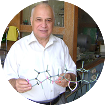Carbohydrate-Containing Marine Compounds of Mixed Biogenesis II
A special issue of Marine Drugs (ISSN 1660-3397).
Deadline for manuscript submissions: closed (31 July 2023) | Viewed by 6094
Special Issue Editors
Interests: marine natural product chemistry; glycosides; glycoconjugates; steroids; terpenoids; uncommon glycolipids; other marine metabolites; structures; bioactivities; chemistry; biochemistry; cell biology; pharmacology
Special Issues, Collections and Topics in MDPI journals
Interests: marine natural product chemistry; secondary metabolites; starfish polar steroids and lipids; biological activities; metabolomics; biosynthesis
Special Issues, Collections and Topics in MDPI journals
Special Issue Information
Dear Colleagues,
There are many classes of natural compounds, possessing monosaccharide or oligosaccharide moieties, that are derived from mixed biogenesis. Carbohydrate-containing marine natural products represent one of biggest groups among such compounds. They are isolated from marine vertebrate and invertebrate animals, algae, fungi, and bacteria and include steroid and terpenoid glycosides, glycolipids, lipopoly- and lipooligosaccharides, glycosides of polyphenolic metabolites, glycosylated peptides, and polyketides, for example, glycosylated antibiotics, and so on. The inclusion of carbohydrate fragments in their structures usually leads to high physiological and/or environmental activities. Organisms living in the marine environment often produce water-soluble natural compounds that embody carbohydrate fragments as their hydrophilic components. These compounds often also contain a hydrophobic fragment which facilitates their interaction with cellular membrane and membrane proteins. Motivated by the success of the recent Special Issue “Carbohydrate-containing marine compounds of mixed biogenesis” (https://www.mdpi.com/journal/marinedrugs/special_issues/Carbohydrate-Containing) in the journal Marine Drugs, we have decided to pursue a follow-up Special Issue, “Carbohydrate-containing marine compounds of mixed biogenesis II”. We welcome your submissions to the Special Issue.
Prof. Dr. Valentin A. Stonik
Dr. Natalia V. Ivanchina
Guest Editors
Manuscript Submission Information
Manuscripts should be submitted online at www.mdpi.com by registering and logging in to this website. Once you are registered, click here to go to the submission form. Manuscripts can be submitted until the deadline. All submissions that pass pre-check are peer-reviewed. Accepted papers will be published continuously in the journal (as soon as accepted) and will be listed together on the special issue website. Research articles, review articles as well as short communications are invited. For planned papers, a title and short abstract (about 100 words) can be sent to the Editorial Office for announcement on this website.
Submitted manuscripts should not have been published previously, nor be under consideration for publication elsewhere (except conference proceedings papers). All manuscripts are thoroughly refereed through a single-blind peer-review process. A guide for authors and other relevant information for submission of manuscripts is available on the Instructions for Authors page. Marine Drugs is an international peer-reviewed open access monthly journal published by MDPI.
Please visit the Instructions for Authors page before submitting a manuscript. The Article Processing Charge (APC) for publication in this open access journal is 2900 CHF (Swiss Francs). Submitted papers should be well formatted and use good English. Authors may use MDPI's English editing service prior to publication or during author revisions.
Keywords
- marine natural product chemistry
- glycosides
- glycoconjugates
- steroids
- terpenoids
- uncommon glycolipids
- other marine carbohydrate-containing metabolites
- structures
- bioactivities
- syntheses
- bioactivities







